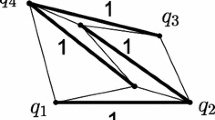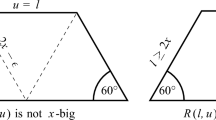Abstract
Any collection of homothetic copies of some tetrahedron \(T_r\), whose total volume does not exceed one quarter of the volume of \(T_r\), can be packed into \(T_r\) .
Similar content being viewed by others
Avoid common mistakes on your manuscript.
1 Introduction
We say that convex bodies \(\ C_1, C_2, \ldots \) can be packed into a convex body C if it is possible to apply translations and rotations to the sets \(C_n\) so that the resulting translated and rotated bodies are contained in C and have mutually disjoint interiors. It is known that if C is either a square [1], or a triangle (see [2] and [3]), or a disk [4], then any collection of homothetic copies of C, whose total area does not exceed half the area of C can be packed into C. The conjecture is that the same packing density is achievable for any planar convex body (see [5] and [6]). However, only the following upper bound was found [7]: any collection of homothetic copies of C, with total area not greater than a quarter of the area of C, can be packed into C.
Meir and Moser [8] proved that any collection of d-dimensional cubes, whose total volume does not exceed \(2^{1-d}\) times the volume of K, can be packed into the d-dimensional cube K. In the paper [2] concerning packing of triangles, Richardson writes: “The original paper of Kranakis and Meertens [9] conjectured that Theorem 1 may be extendible to families of similar tetrahedra (in three dimensions) or even to any family of similar d-dimensional simplexes.” We confirm this conjecture in three dimensions for a tetrahedron \(T_r\) of vertices (0, 0, 0), (0, 1, 0), (1, 1, 0) and (0, 0, 1). We will show that any collection of homothetic copies of \(T_r\), whose total volume does not exceed one quarter of the volume of \(T_r\), can be packed into \(T_r\).
2 Division of \(T_r\)
The unit cube can be divided into two congruent triangular prisms. Observe that such a prism can be partitioned into three tetrahedra congruent to \(T_r\) (see Fig. 1). The unit cube can be partitioned into six tetrahedra congruent to \(T_r\).
Denote by \(\lambda T_r\) the image of \(T_r\) in the homothety with ratio \(\lambda \) and center (0, 0, 1). Moreover, let \(\ a_1\ge a_2 \ge \ldots \ \) be positive numbers, let \(S_i=a_i T_r\) for \(\ i=1,2,\ldots \ \) and let \(\ a_1^3+a_2^3+\ldots \le 1/4\). Obviously, \(\ a_1+a_2 \le 1\), otherwise \(\ a_1^3+a_2^3 > (1/2)^3+(1/2)^3=1/4\), which is a contradiction.
To describe the method of packing tetrahedra \(S_1, S_2, \ldots \) into \(T_r\), let’s introduce some notations. Denote by \(k_1\) the smallest integer such that
(\(k_1=3\) in Fig. 3); if \(a_4+a_7>1-a_1\), then \(k_1=1\). Moreover, let \(k_2\) be the smallest integer such that
(\(k_2= 7\) in Fig. 3). At the end of this section we will define layers and slices. According to the packing method described in Sect. 3, tetrahedra \(\ S_1, \ldots , S_{6k_1}\ \) will be packed into the first layer of the first slice; tetrahedra \(\ S_{6k_1+1}, \ldots , S_{6k_2}\ \) will be packed into the second layer of the first slice. If
for \(i\ge 2\), then denote by \(k_{i+1}\) the smallest integer such that
If j is the smallest integer such that
then we take \(s_1=a_{6k_j+2}\) (\(j=5\) and \(k_j=13\) in Fig. 3, right).
Tetrahedra will be packed into layers \(L_i\) contained in slices \(H_n\). In Sect. 3 we will compare the total volume of tetrahedra packed into \(L_i\) with the volume of some layer \(L_i^*\). Let
and
(see Fig. 2). Moreover, let
3 Packing Method
Observe that \( S_1, S_2\) and \(S_3\) can be packed into the part of \(L_1\) with \(\ y\ge 1-a_1\) (see Figs. 1, 3, 4). Moreover, \(S_4, S_5, \ldots , S_{9}\) can be paced into the cube
Packing method, Part I.
Tetrahedra \(S_1, S_2, \ldots , S_{6k_1}\) are packed into \(L_1\) (see Figs. 3, 4, where \(k_1=3\)). Tetrahedra \(S_{6k_i+1}, S_{6k_i+2}, \ldots , S_{6k_{i+1}}\) are packed into \(L_{i+1}\), for \(i=1,2, \ldots , j-1\). Moreover \(S_{6k_j+1}=S_{s_1-1}\) is placed in \(L_{j+1}\). Clearly, all packed tetrahedra \(S_1, \ldots , S_{s_1-1}\) are contained in \(H_1\).
Lemma 1
The sum of volumes of \(S_2, \ldots , S_{s_1}\) is greater than the volume of \(H_1^*\).
Proof
It is easy to verify that \(\ c^3/2+d^3/2 \ge cd^2,\) provided that \(\ 0<d\le c <1\). Consequently,
Moreover, if \(a_1+a_4+a_7\le 1\), then
etc. This means that that the total volume of tetrahedra \(S_2, S_3, \ldots , S_{6k_1+1}\) is greater than the volume of \(L_1^*\) (see Fig. 4). For the same reason, the total volume of tetrahedra \(S_{6k_i+2}, \ldots , S_{6k_{i+1}+1}\) is greater than the volume of \(L_{i+1}^*\), for \(i=1,2, \ldots , j-1\). This implies that the sum of volumes of \(S_2, \ldots , S_{s_1}\) is greater than the volume of \(H_1^*\) (see Fig. 5 ).
An additional explanation is required if \(\ a_1+a_{6k_1+1}+ \ldots + a_{6k_m+1}+a_{6k_m+2} \le 1\), while \(\ a_1+a_{6k_1+1}+ \ldots + a_{6k_m+1}+a_{6k_m+1} > 1\ \) for some integer m. We can imagine that \(S_{80}\) can be packed into \(L_6\) in Fig. 3 (left). In this case there is enough space to pack \(\ S_{6k_m+1}, S_{6k_m+2}\) and \(\ S_{6k_m+3}\) into the part of \(L_{m+1}\) with \(\ y \ge 1-a_{6k_m+1}\) (see Fig. 6). Clearly, at least three next tetrahedra \(\ S_{6k_m+4}, S_{6k_m+5}\) and \(\ S_{6k_m+6}\) can be packed into this layer. Moreover, \(m<j\), i.e., \(S_{6k_{m+1}+1 }\) is placed in the next layer in \(H_1\). \(\square \)
Packing method, Part II.
Similar to Lemma 1, one can find an integer \(s_2\) such that tetrahedra \(S_{s_1}, \ldots , S_{s_2-1}\) can be packed into \(H_2\) and that the sum of volumes of \(S_{s_1+1}, \ldots S_{s_2}\) is greater than the volume of \(H_2^*\), where
and
Assume that \(s_2, \ldots , s_k\) are defined for \(k\ge 2\) and that \(\ a_1+a_{s_1}+\ldots + a_{s_k} \le 1\). Then there exists an integer \(s_{k+1}\) such that tetrahedra \(S_{s_k}, \ldots , S_{s_{k+1}-1}\) can be packed into \(H_{k+1}\) and that the sum of volumes of \(S_{s_k+1}, \ldots , S_{s_{k+1}}\) is greater than the volume of \(H_{k+1}^*\), where \(\ H_{k+1} = H_k^* \ \) and
provided that \(\ a_1 +a_{s_1}+\ldots + a_{s_{k+1}} \le 1\ \) or
provided that \(\ a_1 +a_{s_1}+\ldots + a_{s_{k+1}} > 1\). In the latter case we stop the packing process; there is not enough space in \(T_r\) to create a new slice of height \(a_{s_{k+1}}\).
Theorem 2
Any collection of homothetic copies of \(T_r\), whose total volume does not exceed 1/24, can be packed into \(T_r\).
Proof
Let \(S_1, S_2, \ldots \) be a collection of homothetic copies of \(T_r\) with total volume not greater than 1/24. Without loss of generality we can assume that \(a_1\ge a_2 \ge \ldots \), where \(S_i=a_iT_r\), for \(i=1,2,\ldots \) Assume that the tetrahedra cannot be packed into \(T_r\) by the method described above. This implies that there is an integer l such that \(a_1+a_{s_1}+\ldots +a_{s_l}>1\). The sum of volumes of \(S_2, \ldots , S_{s_l}\) is greater than the sum of volumes of \(H_1^*, \ldots , H_{s_l}^*\), i.e., is greater than \(\frac{1}{6}(1-a_1)^3\). As a consequence, the total volume of all tetrahedra \(S_1, S_2, \ldots \) is greater than
which is a contradiction. \(\square \)
Availability of Data and Material
Not applicable.
References
Moon, J.W., Moser, L.: Some packing and covering theorems. Colloq. Math. 17, 103–110 (1967)
Richardson, T.: Optimal packing of similar triangles. J. Comb. Theory Ser. A 69, 288–300 (1995)
Januszewski, J.: Optimal translative packing of homothetic triangles. Stud. Sci. Math. Hung. 46(2), 185–203 (2009)
Fekete, S.P., Keldenisch, P., Scheffer, Ch.: Packing discs into disk with optimal wors-case density. Discret. Comput. Geom. 69, 51–90 (2023)
Soifer, A.: Packing clones in convex figures. Geombinatorics 8(1), 110–115 (1998)
Novotny, P.: A note on packing clones. Geombinatorics 11(1), 29–30 (2001)
Januszewski, J.: Translative packing of a convex body by sequences of its positive homothetic copies. Acta Math. Hung. 117(4), 349–360 (2007)
Meir, A., Moser, L.: On packing of squares and cubes. J. Comb. Theory Ser. A 5, 126–134 (1968)
Kranakis, E., Meertens, L.: Optimal Packing of Triangles. Bull. Eur. Assoc. Theor. Comput. Sci. 38, 181–185 (1989)
Funding
Not applicable.
Author information
Authors and Affiliations
Corresponding author
Ethics declarations
Conflict of interest
The authors declare that they have no conflict of interest.
Ethics Approval
Not applicable.
Consent to Participate
Not applicable.
Consent for Publication
Not applicable.
Code Availability
Not applicable.
Additional information
Publisher's Note
Springer Nature remains neutral with regard to jurisdictional claims in published maps and institutional affiliations.
Both authors (Janusz Januszewski and Łukasz Zielonka) contributed equally to this work.
Rights and permissions
Open Access This article is licensed under a Creative Commons Attribution 4.0 International License, which permits use, sharing, adaptation, distribution and reproduction in any medium or format, as long as you give appropriate credit to the original author(s) and the source, provide a link to the Creative Commons licence, and indicate if changes were made. The images or other third party material in this article are included in the article's Creative Commons licence, unless indicated otherwise in a credit line to the material. If material is not included in the article's Creative Commons licence and your intended use is not permitted by statutory regulation or exceeds the permitted use, you will need to obtain permission directly from the copyright holder. To view a copy of this licence, visit http://creativecommons.org/licenses/by/4.0/.
About this article
Cite this article
Januszewski, J., Zielonka, Ł. Packing a Tetrahedron by Similar Tetrahedra. Results Math 79, 61 (2024). https://doi.org/10.1007/s00025-023-02094-z
Received:
Accepted:
Published:
DOI: https://doi.org/10.1007/s00025-023-02094-z










